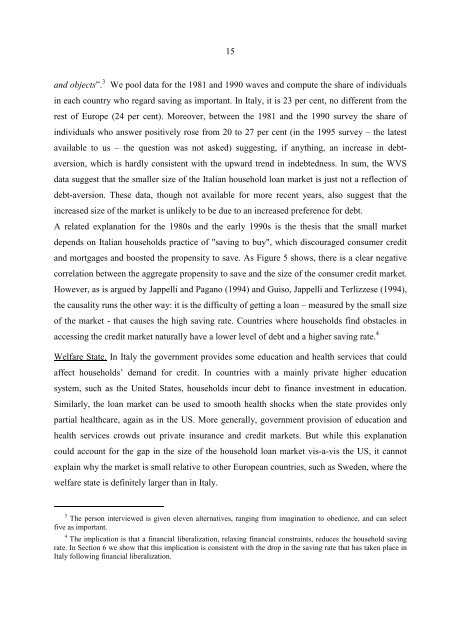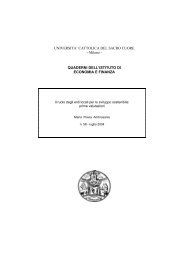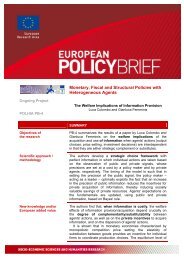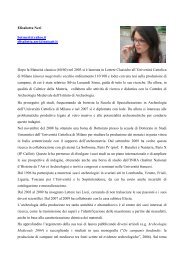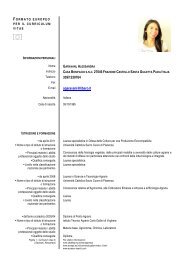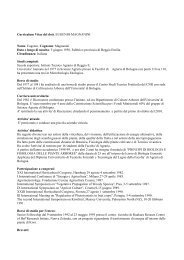REGULATION, FORMAL AND INFORMAL ... - ResearchGate
REGULATION, FORMAL AND INFORMAL ... - ResearchGate
REGULATION, FORMAL AND INFORMAL ... - ResearchGate
You also want an ePaper? Increase the reach of your titles
YUMPU automatically turns print PDFs into web optimized ePapers that Google loves.
15<br />
and objects”. 3 We pool data for the 1981 and 1990 waves and compute the share of individuals<br />
in each country who regard saving as important. In Italy, it is 23 per cent, no different from the<br />
rest of Europe (24 per cent). Moreover, between the 1981 and the 1990 survey the share of<br />
individuals who answer positively rose from 20 to 27 per cent (in the 1995 survey – the latest<br />
available to us – the question was not asked) suggesting, if anything, an increase in debtaversion,<br />
which is hardly consistent with the upward trend in indebtedness. In sum, the WVS<br />
data suggest that the smaller size of the Italian household loan market is just not a reflection of<br />
debt-aversion. These data, though not available for more recent years, also suggest that the<br />
increased size of the market is unlikely to be due to an increased preference for debt.<br />
A related explanation for the 1980s and the early 1990s is the thesis that the small market<br />
depends on Italian households practice of "saving to buy", which discouraged consumer credit<br />
and mortgages and boosted the propensity to save. As Figure 5 shows, there is a clear negative<br />
correlation between the aggregate propensity to save and the size of the consumer credit market.<br />
However, as is argued by Jappelli and Pagano (1994) and Guiso, Jappelli and Terlizzese (1994),<br />
the causality runs the other way: it is the difficulty of getting a loan – measured by the small size<br />
of the market - that causes the high saving rate. Countries where households find obstacles in<br />
accessing the credit market naturally have a lower level of debt and a higher saving rate. 4<br />
Welfare State. In Italy the government provides some education and health services that could<br />
affect households’ demand for credit. In countries with a mainly private higher education<br />
system, such as the United States, households incur debt to finance investment in education.<br />
Similarly, the loan market can be used to smooth health shocks when the state provides only<br />
partial healthcare, again as in the US. More generally, government provision of education and<br />
health services crowds out private insurance and credit markets. But while this explanation<br />
could account for the gap in the size of the household loan market vis-a-vis the US, it cannot<br />
explain why the market is small relative to other European countries, such as Sweden, where the<br />
welfare state is definitely larger than in Italy.<br />
3<br />
The person interviewed is given eleven alternatives, ranging from imagination to obedience, and can select<br />
five as important.<br />
4<br />
The implication is that a financial liberalization, relaxing financial constraints, reduces the household saving<br />
rate. In Section 6 we show that this implication is consistent with the drop in the saving rate that has taken place in<br />
Italy following financial liberalization.


